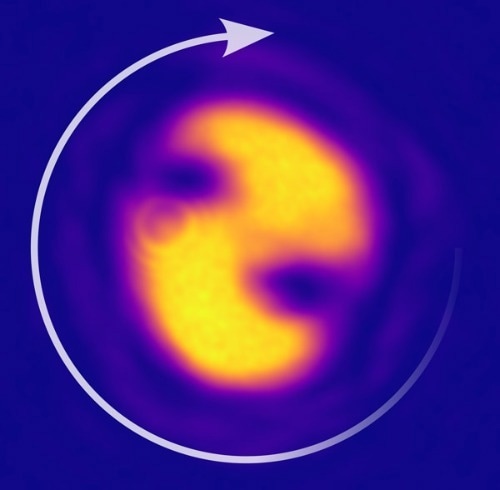RIKEN physicists created several vortices in a quantum photonic system and tracked their evolution using a special combination of laser beams as a very fast stirrer.
 Snapshots of a laser beam that RIKEN researchers used to rapidly stir a polariton condensate. The profile can rotate in a clockwise (indicated) or counter-clockwise direction. Image Credit: RIKEN Center for Emergent Matter Science.
Snapshots of a laser beam that RIKEN researchers used to rapidly stir a polariton condensate. The profile can rotate in a clockwise (indicated) or counter-clockwise direction. Image Credit: RIKEN Center for Emergent Matter Science.
This system is used to explore exotic new physics associated with the beginning of quantum states from vortex matter.
For instance, swimming in a superfluid pool takes a single stroke than swimming in water with an infinite number of laps. Thus, superfluids have no resistance to motion below a certain velocity compared to water.
Superfluids exhibit peculiar behavior when agitated.
If you stir a bucket of water, you typically get just one big vortex. But when you rotate a superfluid, you initially create one vortex. And when you rotate it faster, you get progressively more and more vortices of precisely the same size.
Michael Fraser, Center for Emergent Matter Science, RIKEN
Although observed in liquid helium and atomic systems, a manifestation of superfluidity arises in a system composed of particle-like entities called polaritons.
These entities emerge when a photon of light strongly couples with a negative electron bound to a positive hole in a semiconductor. Researchers aim to agitate these systems, yet this presents a challenge due to the necessity of employing exceedingly high frequencies—millions of times faster than those required for atomic systems.
To create ensembles of vortices, Fraser and co-workers have used a specially crafted laser beam to incoherently stir such a polariton condensate.
These condensates have been around for more than 15 years, and a lot of interesting physics has been done with them. But rotation of a polariton superfluid causing multiple vortices to collect and freely evolve had not been achieved before.
Michael Fraser, Center for Emergent Matter Science, RIKEN
A special laser beam stirrer is made by combining a regular laser beam with a donut-like shape by the team. The beams' frequencies had a slight disparity, aligning with the necessary frequency for polariton rotation.
Leveraging this beam, the researchers managed to regulate both the speed and rotational direction of the polaritons, enabling the deliberate formation of vortices. Their demonstration indicated that increased rotation speed resulted in the capture of more vortices near the axis of rotation.
Moreover, the experimental measurements are close to simulations based on theory.
Our rotation scheme thus allows the study of self-ordering vortex dynamics in an open-dissipative platform - one that continually loses and gains particles. This is especially exciting as not only do we expect it to exhibit new vortex phenomena, but it is also opens up opportunities to study highly quantum, topological phases of light.
Michael Fraser, Center for Emergent Matter Science, RIKEN
Journal Reference:
Redondo, V, Y., et al. (2023). Optically Driven Rotation of Exciton–Polariton Condensates. ACS Publications. doi/10.1021/acs.nanolett.3c01021.